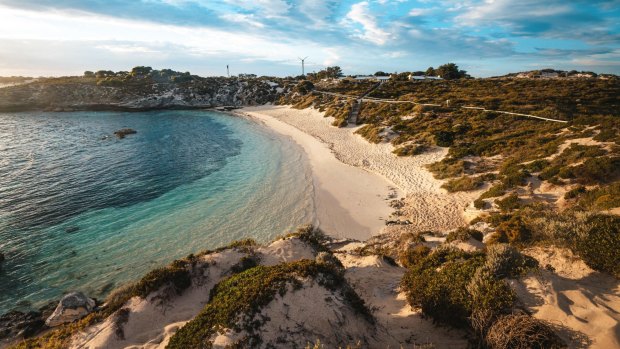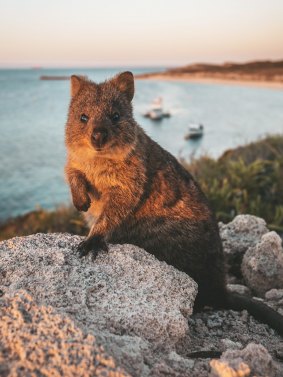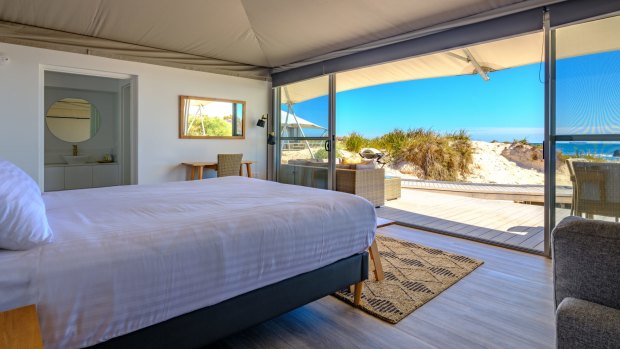This was published 5 years ago
Discovery Rottnest Island, Western Australia: Where to see Australia's famous quokkas
By Catherine Marshall

Sunrise at Fays Bay, Rottnest Island.Credit: James Vodicka
No man is an island – which is why the blokes are crowding on to the ferry together for their annual dads-and-sons getaway to Rottnest Island. Their conviviality is cacophonous as we speed across the ocean towards that slip of land lying flat against the horizon. Dads catch up in voices raised above the engines' drone, sons roar victoriously as the ferry overtakes a private boat carrying one of their friends to the same destination.
But at Rottnest Island the racket dissolves on the fresh air. Passengers pour out on to the wharf, bicycles roll off the ferry and their owners ride them into the (almost) sunset. Liberated from the rules of the city, they're free to roam this compact universe.
No man is an island, but islands are exactly that – and they flourish best when left alone. Rottnest had 7000 years of solitude after breaking off from the mainland before humans turned up again (the Whadjuk Noongar people had used it as a meeting place and ceremonial site before the geological rift; they call it the spirits' resting place). In the years since, it's put up with all manner of human interference, been forced to perform utilitarian functions that were clearly anathema to its carefree temperament: pine plantation, army barracks, internment camp for German POWs, prison for Indigenous men, reformatory for boys, salt mine, limestone quarry.

A quokka on Rottnest Island.Credit: James Vodicka
But Rottnest is slowly reverting to its natural state, and those who visit – half a million last year – seem to prefer it that way. Quokkas, for which the island is most famous, are back in charge. They roam about the Settlement (as the island's historic village is known), nibbling at ti tree leaves and posing with tourists for sought-after quokka selfies (strict guidelines apply. See rottnestisland.com).
"As you can see we haven't got a shortage," says Deb Cook, Rottnest Island Authority volunteer guide. "They do tend to look a bit drunk in the daylight, because they're nocturnal."
Island life has saved these creatures from probable extinction. With no natural enemy, their longevity was assured when Rottnest broke free of a mainland that would later be inundated with destructive introduced species (a small group of genetically unrelated quokkas still exists in south-western West Australia). Although cats appeared on the island, too, they've since been eradicated and Rottnest declared a Class A Reserve. Left to their natural devices, quokkas have flourished. Although long, hot, dry summers are a threat to weaker members of the species, the island is now home to a steady population of around 10,000.

Eco-friendly accommodation on Rottnest Island.Credit: Discovery Rottnest Island
"They mate immediately after the first bub is born and hold a fertilised embryo in case the first one doesn't survive," Cook says. "It's like the royal family, an heir and a spare!"
Other island habitats have also come full circle. Marine life flourishes in the sanctuaries rimming the island's curlicue perimeter. Denuded hillocks are being reclothed as part of a native bush regeneration program. Fat ospreys roost on a rock overlooking a surf break; their nest has occupied this blue-ribbon spot for as many as 90 years.
In the spirit of this back-to-basics philosophy, the island's newest development adheres to organic principles. Overlooking Pinky's Beach, Discovery Rottnest Island is a gathering of 83 stilted eco-tents connected by boardwalks that allow nature to proceed undisturbed. At sunset, the resort's promenade is a choreographed show reel in which the backdrop is the star and visitors minor players: families drying off on a golden ribbon of beach; couples clinking champagne flutes against a reddening sky; turquoise waters – translucent by day – pulling nighttime's inky shutters across their surface; bartenders mixing sundowners while quokkas, awakening from their daytime slumber, help themselves to freshly planted lawn outside the resort's hub, Pinky's Beach Club.
Some of them are hungry for human food. As I eat dinner at the club restaurant, I hear a rustle beside me. A quokka is peering at me through the wooden slats demarcating the restaurant's boundary. She must have detected the scent of the saltbush pangritata in my baby beetroot salad: standing on hind legs, she presses her fore paws together and bores her raisin eyes into mine. "Please ma'm, can I have some?" she seems to be saying. I decline, but next morning find my wooden key ring, which I'd lost outside my tent on the way to bed, lying outside my front door with several quokka-sized nibbles taken from it.
Beyond the campsites and the low-slung settler-buildings-turned-B&Bs spreads the quokkas' broader habitat, a patchwork of marshes and woodland, heath and salt lakes filled with brine shrimps. Dispersed among them are made-made devices built not to impose order on the island but to nurture self-sustainability and environmental care. A desalination plant supplies drinkable water, while solar panels and wind turbines generate 30 per cent of the island's energy. (The Rottnest Island Authority aims to increase this output to 45 per cent and visitors can log on to the Rottnest Island Renewable Energy App to see, in real time, how much energy the island uses and supplies).
Transport is mostly eco-friendly, too, for "everyone brings a bicycle to Rottnest," Cook says. The dads and sons navigate the island's contours, feet pedalling, jocularity disappearing on the salt breeze. Swimmers park their bikes beside the road and sink into the numerous bays rimming the island. Soothed by the Leeuwin Current, the water here is warmer than at any Perth beach, says guide Zoe Bailey.
And wakeful quokkas mill about on the verges, foraging for food and acceding to the occasional selfie request, taken against a backdrop described by Dutch explorer Willem de Vlamingh when he arrived here in 1696 as "heaven on Earth".
"But his descriptions went downhill rapidly," Bailey says. "There was no fresh water, very thick vegetation, and 'rats the size of cats.' "
Under this illusion he named the island Rottnest, or "rats' nest" in Dutch. No rat (or, rather, quokka) is an island, he might well have thought, but if not for this island they might not have existed at all.
FIVE MORE ISLANDS IN WESTERN AUSTRALIA
CARNAC ISLAND
This island south of Fremantle is a bachelors' paradise for male sea lions, which migrate here (sans females) after mating on WA's north coast. Other inhabitants include seabirds such as little penguins and terns and deadly tiger snakes. Access is by boat and is limited to day visits. See parks.dpaw.wa.gov.au/park/carnac-island
PENGUIN ISLAND
Little penguins, the world's smallest penguin species, make their homes in burrows on this island in the Shoalwater Islands Marine Park off Rockingham, south of Perth. Walking, snorkelling, cruising and birdwatching are favourite activities here. The island is open daily from mid-September to early June when it closes to accommodate penguin nesting season. See penguinisland.com.au
WOODY ISLAND
Keep your eyes peeled for the elusive leafy sea-dragon on Woody Island's underwater snorkel trail, or step ashore and look out for bandicoots, wallabies and a variety of seabirds while exploring this wildlife-rich nature reserve, one of 100 islands in the Recherche Archipelago off the coast of Esperance on WA's south coast. Eco-accommodation is available. See woodyisland.com.au
DIRK HARTOG ISLAND
Located in the Coral Coast's Shark Bay World Heritage Area, this island is fast gaining a reputation as a nature-based destination. The adventure starts with a barge crossing from the mainland and continues with fishing, kayaking, snorkelling, eco-cruising and 4WD tours – and watching the sunset from the most westerly point on the Australian mainland. Accommodation ranges from national park camping to a private ocean villa. See dirkhartogisland.com
HEIRISSON ISLAND
Squatting in the middle of Perth's Swan River and bisected by the Causeway Bridge, this island-within-a-city is rich in Noongar history and was once these people's main crossing point from one side of the shallow river to the other. Today it's a kangaroo sanctuary and a pleasant picnic spot. See parks.dpaw.wa.gov.au/site/heirisson-island
TRIP NOTES
Catherine Marshall was a guest of Tourism Western Australia.
MORE
FLY
Qantas flies daily to Perth from Australia's major cities. Rottnest Express operates regular return services from Perth and Fremantle to Rottnest Island. See qantas.com.au; rottnestexpress.com.au
STAY
Accommodation at Discovery Rottnest Island is priced from $119 a night in low season for a standard eco-tent to $592 a night for a deluxe eco-tent in high season. See discoveryholidayparks.com.au/discovery-rottnest-island
TOUR
Rottnest Express offers a variety of tour packages and experiences on the island including skydiving, cruises, Segway tours and bike and snorkel hire. See rottnestexpress.com.au
Sign up for the Traveller Deals newsletter
Get exclusive travel deals delivered straight to your inbox. Sign up now.